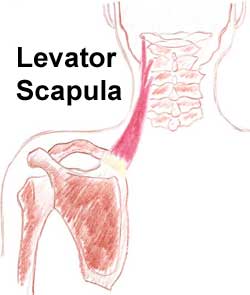
Where is it?
The Levator Scapula starts at your neck vertebra (its origin), attaching to the transverse processes of C1 to c4 (these are the bones that stick out to the side of each vertebrae). Each vertebra has a letter and number to designate where each vertebra is in your spinal column. C stands for Cervical – the neck part of your spine. There are 8 vertebra in the Cervical spine, so the Levator Scapula is covering half of it at it’s origin. The muscle’s other attachment (its insertion) is at the scapula to medial border of the scapula, along the superior angle to the root of the spine of your scapula.
You can find the muscle’s attachment points using your fingers to run along the side of your neck vertebra. If you can, reach over your shoulder to find the top corner of your scapula, nearest the neck (that’s probably as much as you can easily reach). You won’t, however, be able to actually feel your Levator Scapula is it actually lies beneath your large back muscle, the Trapezius.
What does it do?
The clue to the Levator scapula’s funcion lies in the name of the muscle itself. Levator = elevate and Scapula = well, scapula.
As there are 2 Levator Scapula, one on on each side of your neck. They can work both independently (unilaterally) and together (bilaterally).
Unilaterally they raise your scapula. Go on shrug one of your shoulders and say hello to the the Levator Scapula in action. Even if you shrug both your shoulders together, they are still working independently of each other. They also downwardly rotate the scapula.
If you flex your head and neck to the side, or turn your head, the Levator Scapula on that side of your neck is contracting to make that movement.
Bilaterally, they extend the head and neck. So when you stand tall and hold your head high -showing good posture – your Levator Scapula muscles are working together to help you maintain that position.
When you next look over your shoulder to manoeuvre your car, or balance your mobile phone between your ear and shoulder, think of your Levator Scapula and how hard is is working.
Common Problems
How many times has someone said to you to relax your shoulders? What this means is that your Levator Scapula has become stuck in the elevated position. Why does this happen? Well here are 3 possible ways:
- Carrying a bag on one shoulder or arm all the time means that the Levator Scapula will have elevate the scapula to counter balance the weight. If this becomes a movement it must perform continually the muscle can find it difficult to function as it should. In effect it just stays locked in an elevated position.
- If your head continually falls forward from looking at the ground as you walk or looking down at your mobile device, then the Levator Scapula, along with your other neck muscles, have to work really hard to support your head (the heaviest part of your body) in a position. To pull your head back up they must fight gravity and as they become weaker, this becomes harder to do.
- If you’re feeling stressed, one of the most common postural responses is to hunch up your shoulders and without relief, they can often stay there. This can often happen without you realising it, although you might identify with a feeling of ‘slumped shoulders”.
Eventually, you may become aware of a pain or stiffness in your head or neck, perhaps even a headache. Most people though would find it hard to identify where the problem started.
Stretches for your Levator Scapula
Here are 2 stretches for your Leveator Scapula:
While looking forward and with your head up, slowing move your ear towards your shoulder. Keep your hands behind your back.
Whilst standing, let your chin fall forwards towards your chest. Gently move your head to one side in a circular motion, drawing your chin towards your shoulder. Repeat on the other side.
